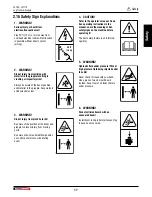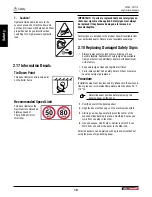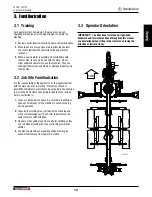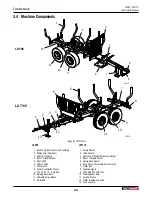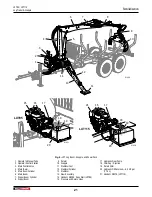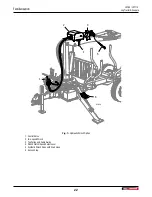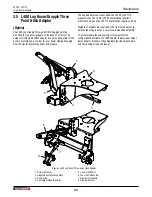
•
Provide instructions to anyone else
who is going to operate the machine.
This equipment is dangerous to anyone
unfamiliar with its operation.
•
Review safety related items annually with all personnel who
will be operating or performing maintenance.
•
Never consume alcohol or drugs while using this
equipment. Alertness or coordination can be affected.
Consult your doctor about using this machine while taking
prescription medications.
•
Avoid loose fitting clothing, loose or uncovered long hair,
jewelry, and loose personal articles. These can get caught
in moving parts. Jewelry may also ground a live circuit.
•
Keep a first-aid kit available for use
should the need arise and know how to
use it.
•
Inspect and secure all shields before starting.
•
Keep a fire extinguisher available for use should
the need arise and know how to use it.
•
Do not expect a person who has not read and understood
all use and safety instructions to operate the machine. An
untrained operator is not qualified and exposes himself
and bystanders to possible serious injury or death. It is the
owner's responsibility to the operator to ensure familiarity
and understanding of the machine.
•
Do not allow riders during transport.
•
Do not risk injury or death by ignoring good safety
practices.
•
Stay a minimum 20 ft (6 m) away from power lines. Power
lines as well as the surrounding air space which insulates
the line can be hazardous. Electricity can arc or jump
through the insulating air space. The higher the voltage, the
more likely it is for an arc to occur.
•
Never swing a load if the operator's line of sight is
obstructed. Do not lift it higher than is necessary to provide
unobstructed vision for the equipment operator.
•
Never use the machine until the operators have been
adequately trained in the safe operation of the machine and
have read and completely understand:
-
Safety, operation and feature sections of this manual
-
Each of the safety messages found on the safety signs
on the machine.
-
Engine operator's manual (as equipped)
•
Extend stabilizers to support and steady the trailer and
boom during loading or stacking. Keep the trailer attached
to the tow vehicle.
•
Always wear appropriate PPE. This equipment includes but
is not limited to the following:
-
A hard hat
-
Heavy gloves
-
Hearing protection
-
Protective shoes with slip resistant soles
-
Protective glasses, goggles, or face shield
•
Train all operators to be familiar with equipment's operation.
The operator should be a responsible, properly trained and
physically able person familiar with machinery. If the elderly
are assisting with work, their physical limitations need to be
recognized and accommodated.
•
Wear hearing protection on a full-time
basis. Prolonged exposure to loud noise
may cause permanent hearing loss!
-
Noise over 85 dB on a long-term
basis can cause severe hearing loss.
-
Noise over 90 dB adjacent to the
Operator over a long-term basis may
cause permanent, total hearing loss.
•
When there are two or more operators, review and
understand a system of hand signals.
•
Keep bystanders away at a safe distance at least 20 ft
(6 m) from stacking zone. Mark the zone with safety cones.
•
Determine a safe work area / trailer location:
-
Area must be clear of stones, branches or hidden
obstacles that might cause a tripping, hooking or
snagging hazard.
-
Ground should be firm and level.
•
Be aware of overhead hazards: branches, cables, electrical
wires.
•
Use only in daylight or good artificial light.
•
Be sure machine is properly stationed, adjusted and in
good operating condition.
•
Ensure that all safety shielding and safety signs are
properly installed and in good condition.
•
If fuel is on site, store it well away from the material pile .
•
Perform the
Pre-start Checks
procedure before starting
work (see
.
2.5 Equipment Safety Guidelines
•
Keep all shields in place. If shield removal becomes
necessary for repairs, replace it prior to use.
Safety
LXT95 / LXT115
Log Trailer & Grapple
Safety
8
Summary of Contents for LXT115
Page 64: ...www wallensteinequipment com ...

















